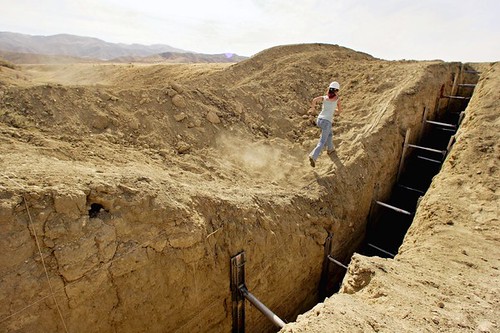Car Jack Planet
An article published today in the Los Angeles Times contains several fascinating details, including scenes of researchers from the Southern California Earthquake Center digging trenches into land surrounding the San Andreas fault.
 [Image: Photo by Ricardo DeAratanha, courtesy of the Los Angeles Times].
[Image: Photo by Ricardo DeAratanha, courtesy of the Los Angeles Times].
There, they use "carbon dating and sophisticated imaging technology known as lidar to find signs of earth movements," and, in the process, are "able to detect earthquakes dating back to the 15th century." Seismic historiography meets the earth-archive.
The other detail worth highlighting, however, is what you see in the image above: "Sarah Robinson, 23, a graduate student at Arizona State University, runs along a trench at the Bidart Fan sector of the San Andreas fault in June 2009. She is on a team of geologists trying to construct a history of earthquakes on the San Andreas fault by reading lines of sediment in the earth." Robinson is running alongside one of these excavations, a clearly defined cut that yawns open like a wound in the earth's surface—implying the possibility of faults artificially held open, like something from a dream by Lebbeus Woods. It is a scar, poised on the verge of healing, but for these metallic insertions, spatial implements squeezed into the planet like car jacks, bringing new tectonic plates into existence from the top-down.
Imagine a rogue, university-funded team of geologists researching ever-lower levels of the earth, forcing themselves downward with separating devices that pin open rocky wounds to split whole landmasses along unanticipated faultlines. Using these tools—terrain deformation grenades gone linear—they create islands in the earth's crust, like walled castles of geology, carving out new blocks in the landscape.
 [Image: Photo by Ricardo DeAratanha, courtesy of the Los Angeles Times].
[Image: Photo by Ricardo DeAratanha, courtesy of the Los Angeles Times].There, they use "carbon dating and sophisticated imaging technology known as lidar to find signs of earth movements," and, in the process, are "able to detect earthquakes dating back to the 15th century." Seismic historiography meets the earth-archive.
The other detail worth highlighting, however, is what you see in the image above: "Sarah Robinson, 23, a graduate student at Arizona State University, runs along a trench at the Bidart Fan sector of the San Andreas fault in June 2009. She is on a team of geologists trying to construct a history of earthquakes on the San Andreas fault by reading lines of sediment in the earth." Robinson is running alongside one of these excavations, a clearly defined cut that yawns open like a wound in the earth's surface—implying the possibility of faults artificially held open, like something from a dream by Lebbeus Woods. It is a scar, poised on the verge of healing, but for these metallic insertions, spatial implements squeezed into the planet like car jacks, bringing new tectonic plates into existence from the top-down.
Imagine a rogue, university-funded team of geologists researching ever-lower levels of the earth, forcing themselves downward with separating devices that pin open rocky wounds to split whole landmasses along unanticipated faultlines. Using these tools—terrain deformation grenades gone linear—they create islands in the earth's crust, like walled castles of geology, carving out new blocks in the landscape.





Comments are moderated.
If it's not spam, it will appear here shortly!
This reminds me of an retrospective of works by Gordon Matta-Clark that I saw at the Chicago Museum of Contemporary Art in 2008.
Matta-Clark literally cut condemned buildings in half with gigantic ship-breaking saws then jacked them apart, and documented the process with video and Cibachrome prints.
It was amazing to see the cracks opening in buildings, knowing that they were demolished days later in a more traditional way. Art and bulldozers, simulating the immediate effect and results of earthquakes...
Thanks for this!
Maybe North and South Korea should cut a fault zone right along the DMZ, then maybe the South can drift away forever.
Post a Comment